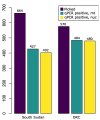Procedure for Handling and Storage of Onchocerca volvulus Microfilariae Obtained from Skin Snips for Downstream Genetic Work
- PMID: 37755906
- PMCID: PMC10536066
- DOI: 10.3390/tropicalmed8090445
Procedure for Handling and Storage of Onchocerca volvulus Microfilariae Obtained from Skin Snips for Downstream Genetic Work
Abstract
WHO and endemic countries target elimination of transmission of Onchocerca volvulus, the parasite causing onchocerciasis. Population genetic analysis of O. volvulus may provide data to improve the evidence base for decisions on when, where, and for how long to deploy which interventions and post-intervention surveillance to achieve elimination. Development of necessary methods and tools requires parasites suitable for genetic analysis. Based on our experience with microfilariae obtained from different collaborators, we developed a microfilariae transfer procedure for large-scale studies in the Democratic Republic of Congo (DRC) comparing safety and efficacy of ivermectin, the mainstay of current onchocerciasis elimination strategies, and moxidectin, a new drug. This procedure is designed to increase the percentage of microfilariae in skin snips suitable for genetic analysis, improve assignment to metadata, and minimize time and materials needed by the researchers collecting the microfilariae. Among 664 microfilariae from South Sudan, 35.7% and 39.5% failed the mitochondrial and nuclear qPCR assay. Among the 576 microfilariae from DRC, 16.0% and 16.7% failed these assays, respectively. This difference may not only be related to the microfilariae transfer procedure but also to other factors, notably the ethanol concentration in the tubes in which microfilariae were stored (64% vs. ≥75%).
Keywords: drug trials; epidemiological studies; genetic analysis; microfilariae; onchocerciasis.
Conflict of interest statement
A.C.K. was staff of WHO/TDR at the time of this work. TDR, via co-author A.C.K., had a role in the development of the procedure, the writing of the manuscript, and in the decision to publish the result. NIAID had no role in the design of this research; in the analyses, or interpretation of data; in the writing of the manuscript; or in the decision to publish the results.
Figures


References
-
- Remme J.H.F., Boatin B., Boussinesq M. Helminthic diseases: Onchocerciasis and loiasis. In: Quah S.R., Cockerham W.C., editors. The International Encyclopedia of Public Health. 2nd ed. Volume 3. Elsevier Inc.; Amsterdam, The Netherlands: 2017. pp. 576–587.
-
- Chesnais C.B., Nana-Djeunga H.C., Njamnshi A.K., Lenou-Nanga C.G., Boulle C., Bissek A.Z., Kamgno J., Colebunders R., Boussinesq M. The temporal relationship between onchocerciasis and epilepsy: A population-based cohort study. Lancet Infect. Dis. 2018;18:1278–1286. doi: 10.1016/S1473-3099(18)30425-0. - DOI - PubMed
-
- Fodjo J.N.S., Mandro M., Mukendi D., Tepage F., Menon S., Nakato S., Nyisi F., Abhafule G., Wonya’rossi D., Anyolito A., et al. Onchocerciasis-associated epilepsy in the Democratic Republic of Congo: Clinical description and relationship with microfilarial density. PLoS Negl. Trop. Dis. 2019;13:e0007300. doi: 10.1016/j.ibror.2019.07.1581. - DOI - PMC - PubMed
Grants and funding
LinkOut - more resources
Full Text Sources

